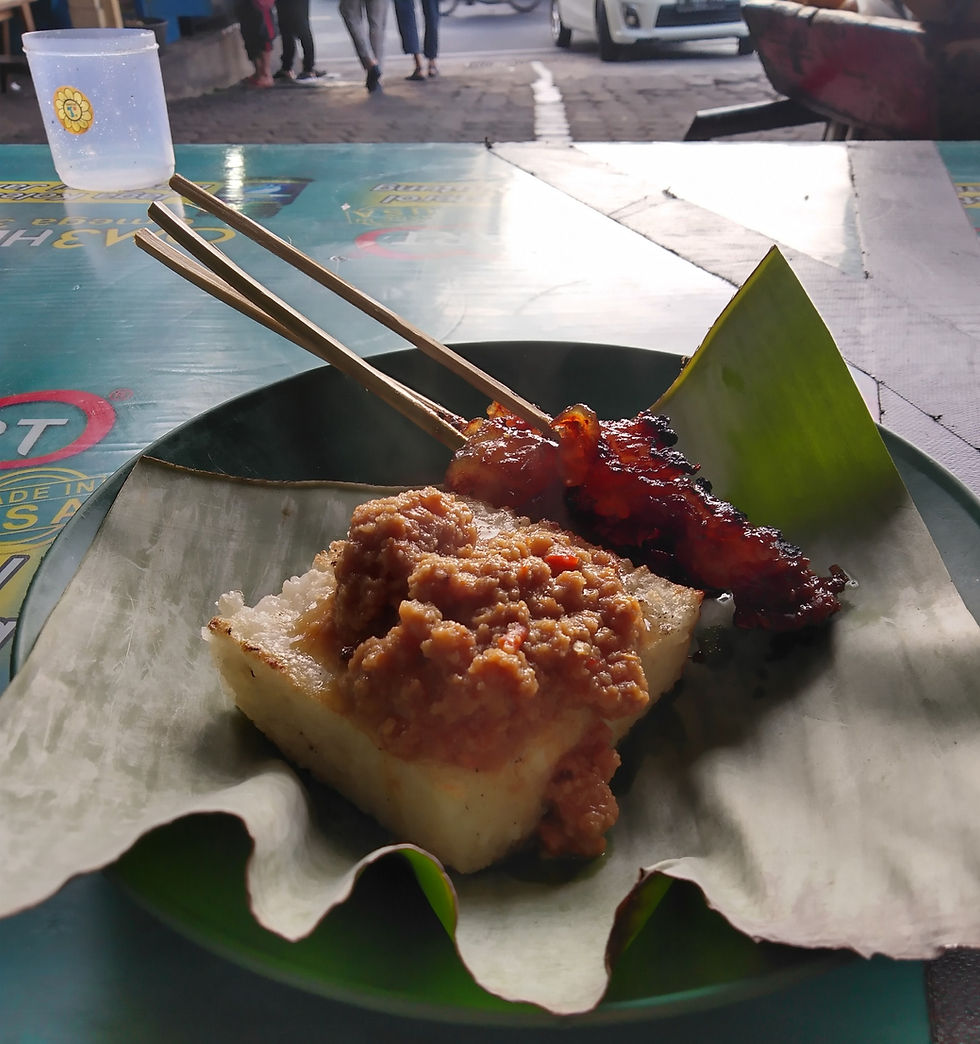Sate Maranggi Cianjur: Ketan Bakar? Oncom?
- Mohammad Ghifari
- Mar 22, 2021
- 3 min read
Updated: Mar 23, 2021

We are all familiar with the norm that sate goes with lontong or ketupat or sometimes just rice. You have two options for your sauce/gravy: peanut or soy sauce, and that was pretty much it.
There was a strange place that became quite known from word of mouth in my circle. It was so good, was an experience, it was worth a drive they said. So, one day we hit the road to Cianjur for a matter I could not recall, and somehow we all agreed to stop by this place and see if the skewers do justice to the reviews.
The next thing I knew, I was staring at a pile of bamboo sticks like how the Spartans piled up dead Persians as defense walls. I thought of myself as Diomedes for a bit there, for the journey was worth it. It was a victory.
Let's break down the reasons why we thought this place was strange in the sate-verse (sate universe).
As we mentioned in the first paragraph, sate normally came with lontong or ketupat or just regular rice as a default setting, and the two kinds of sauce that you may choose from peanut or kecap manis. Then I got there, and I'm pretty sure we can all relate to a time when you stop by a well-known chain restaurant in another country because you're familiar with it; feels like home; for a quick, simple chicken and rice. Then you found out that they don't do rice in most places (yes they do in Indonesia). I'd like to call this situation 'an overnight renovation'. Imagine you wake up tomorrow. The whole house got re-oriented; the kitchen is now a living room, the bathroom moved backward; and now you are trying to find a pen you put on the table last night. You are fully aware that it was your house, but not quite the house you've known your whole life.
I beg to argue that this case is the same. Though not as extreme as an overnight renovation, but you get the idea. It's a sate but not quite the same. Instead, they do ketan bakar (grilled glutinous rice) as their carb source and sambal oncom for some reason we need to find out why. Strange.
Ketan bakar and sambal oncom are a Sundanese thing. It is very common in higher altitude areas; by that meaning colder; to have them as snacks for an afternoon tea. Interesting, I know!
Now, have a look at the picture below there's the sate- in this case, sate maranggi: 3 piece skewer out of meat-fat-meat. I couldn't help but notice the glaze like it has been candied. True enough as we have talked about in our previous sate maranggi in Plered post that the marinate was mainly palm sugar.

The square one is the one we called ketan bakar. It is a steamed glutinous rice and coconut milk which are then shaped into squares followed by chargrilling.
We almost forgot! We haven't talked about oncom, and oh we'll be damned if we forgot about it completely because it is something else altogether. It appeared around the 17th century in West Java. Oncom is a side product or you can say a waste product from soybean or peanut processing. Soybean waste would be fermented to a spore stage and will become what we call 'oncom merah' (red). While peanut waste will become 'oncom hitam' (black). This dish uses oncom merah as the base for their sambal oncom, and it has a pretty apparent earthy taste to it.
Overall I was amazed, even though I had walked out mildly dizzy due to overconsumption of fat and it was sweet, to be honest. The three components were tied together with their earthy flavor from oncom, palm sugar, and coconut milk.
It was definitely worth the drive, and certainly worth another visit.

There you have it!
Another story behind the bite,
Brought to you by GRAMUS
Sate Maranggi Sari Asih
Jalan Ir. H. Juanda Panembong, Mekarsari, Cianjur, Mekarsari, Kec. Cianjur, Kabupaten Cianjur, Jawa Barat 43211
Source:
Khairunnisa, S. N. (2020). Sejarah Oncom Khas Jawa Barat, Olahan Sisa Bahan Makanan. Kompas. Retrieved from





Comments